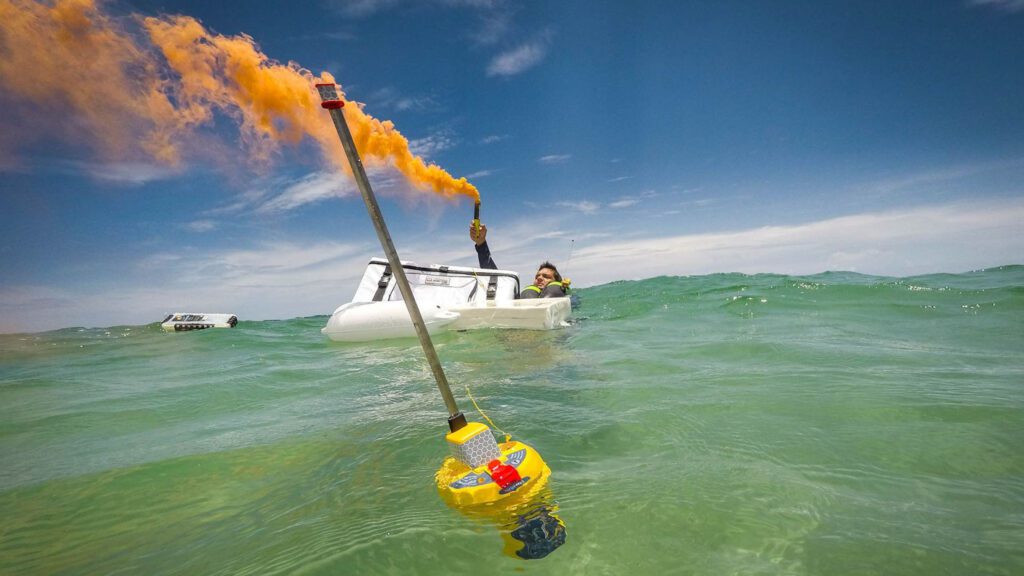
Rescue tech 2025
July 11, 2025

Falling overboard can kill you. Float explores the latest tech that can increase your chances of survival.
The official report is brutally matter-of-fact: “The search operation was suspended after nineteen hours as darkness fell and the weather deteriorated.” Dag E. was lost at sea, disappeared without a trace.
The 33-year-old Swede had been one of hundreds of participants in the Atlantic Rally for Cruisers, the annual fall transatlantic rally that takes yachts from the Canary Islands to the Caribbean, and a rite of passage for many first-time ocean crossers. He had booked a berth aboard the Volvo 70 Ocean Breeze, one of the few boats in the fleet that rents out crew spots.
Dag E. fell overboard from the Ocean Breeze on December 2, around 2 a.m. Despite reportedly wearing a life jacket equipped with a locator beacon, he could not be found. He was eventually declared dead.
Odds of survival are low
“Falling overboard simply isn’t an option,” says Antke Reemts, spokesperson for the German Maritime Search and Rescue Service (DGzRS). It’s the worst-case scenario at sea and must be avoided at all costs. Once it happens, the chances of survival drop dramatically.

Dag’s story highlights the challenges of locating someone in the water, particularly in adverse weather conditions, low visibility, or under stress. And even if they’re spotted, getting them back aboard is a huge physical challenge, as we recently tested ourselves with a two-person crew.
Why, then, didn’t Dag’s locator beacon help? While we don’t yet have the official accident report, Reemts says, “In our experience, many people believe electronics can solve everything at sea.” And often they can, but not always.
Are locator systems effective?
Depending on your cruising area, you’ll need distress signals that can either be seen by others or picked up electronically. These include visual signals (flares or signal rockets), audible signals (whistles, horns, foghorns), radio signals, and satellite signals (EPIRB or PLB).
VHF distress calls are transmitted on Channel 16 or via Digital Selective Calling (DSC) and received by nearby ships or shore stations. AIS MOB devices send updated GPS positions every minute on internationally standardized AIS channels, alerting all AIS-equipped vessels within about 15 nautical miles, including your own boat. For global distress signaling, EPIRBs transmit location data via satellite to rescue coordination centers. A PLB (Personal Locator Beacon) is a compact version designed to be carried in a life jacket.
Are locator systems effective?
Depending on your cruising area, you’ll need distress signals that can either be seen by others or picked up electronically. These include visual signals (flares or signal rockets), audible signals (whistles, horns, foghorns), radio signals, and satellite signals (EPIRB or PLB).
VHF distress calls are transmitted on Channel 16 or via Digital Selective Calling (DSC) and received by nearby ships or shore stations. AIS MOB devices send updated GPS positions every minute on internationally standardized AIS channels, alerting all AIS-equipped vessels within about 15 nautical miles, including your own boat. For global distress signaling, EPIRBs transmit location data via satellite to rescue coordination centers. A PLB (Personal Locator Beacon) is a compact version designed to be carried in a life jacket.
Smartphone app as basic gear
One of the simplest—and free—rescue tools is the SafeTrx app for IOS (iPhone) and Android smartphones. Developed by the Irish Coast Guard, it’s widely recommended, including by the DGzRS. “Before your trip, you enter your estimated arrival time; if you’re overdue, the system triggers an alert,” says Mara Zapp from the Well Sailing sailing school in Neustadt/Ostsee.
Antke Reemts from the DGzRS also says that the app is especially useful near the coast, where mobile coverage exists. SafeTrx relies on your phone’s hardware and signal. Under ideal conditions, the range may be 10–20 nautical miles. Outside mobile coverage, SafeTrx uses a route plan and alerts emergency contacts via SMS if you don’t arrive as expected.
But if your phone goes in the water with you? Not good. “It’s highly unlikely a phone floating in the sea would maintain a usable signal,” says Reemts. In those cases, SafeTrx won’t help.
AIS beacons and their limits
Many sailors now rely on AIS MOB devices. Dag reportedly had one. These units transmit a distress signal over AIS and can also trigger a DSC alert on compatible radios.

They’re pre-programmed with a unique MMSI number and appear as an emergency icon on chart plotters. But there’s no guarantee nearby boats will notice or respond. More advanced units can also trigger a DSC alert directly on the radio of their assigned boat. Some models, like easy2-MOB by Weatherdock, escalate to a general “DSC all ships call” if the initial alert isn’t acknowledged within 10 minutes.
AIS MOB devices activate manually or automatically when the life jacket inflates. Transmission range is typically 20–25 nautical miles under ideal conditions, but rough seas can severely limit effectiveness. To increase chances, most devices transmit in 8-second intervals, hoping to catch a moment at the wave crest.

From A to M
AIS classifies different types of transmitters. Most people are familiar with class A (commercial vessels with mandatory AIS equipment) and class B (voluntary for recreational boats). There are other groups such as AIS base stations for shore-based infrastructure such as traffic control centers, AtoN transceivers (aids to navigation) that can be used on buoys and other navigational aids, or AIS transceivers for search and rescue aircraft.
In 2022, Europe introduced a new Class M specifically for MOB devices. As of 2025, only Class M and AtoN devices will be allowed to use AIS Channels 1 & 2 in certain countries, rendering many older units incompatible. Germany hasn’t adopted this rule yet, and it’s unclear whether PLBs with integrated AIS will be affected. For solo sailors offshore, even the best AIS beacon won’t help much if no one is around to receive it.
The little sister of the EPIRB
PLBs (Personal Locator Beacons) are another widely used safety device. They function like compact EPIRBs, transmitting distress signals via satellite on both 406 MHz and 121.5 MHz frequencies. The first alerts rescue centers; the second acts as a homing beacon for helicopters or aircraft.
Unlike AIS devices, PLBs only alert the official rescue network, not nearby vessels. They must be triggered manually, which avoids false alarms but also means they can’t help an unconscious person.

AIS PLB3Some modern devices, like the PLB3 from Ocean Signal, combine PLB and AIS MOB features. When installed in an automatic life jacket, they can activate on inflation. They also support RLS (Return Link Service), a two-way signal that confirms via LED whether your distress call was received, a major comfort in an emergency.
In Germany, PLBs aren’t officially supported for individual registration. They can only be registered as EPIRBs under a boat’s MMSI, unless you work around the system by registering in another country (e.g., the UK).

The combination of PLB and AIS MOB enables you to trigger the global rescue system via satellite and simultaneously alert nearby vessels via AIS.
“It’s all about habits”
Sailing instructor Mara Zapp says that you should spare no expense. “If I own a boat and sail with others, no expense should be spared. People don’t like to think about emergencies, but safety is really just a habit like wearing a seatbelt.”
And those habits start with the basics: a reliable life jacket. A 2010 survey by the FSR, the German marine safety association, found that over 90% of sailing yachts in Germany were equipped with life-saving gear. But whether the crew actually wears it remains unknown.

In September 2015, a sailor fell overboard from the yacht Desdemona off Warnemünde during a routine maneuver. It was midday with calm seas and moderate winds. He wasn’t wearing a life jacket and couldn’t be rescued in time. The 42-year-old drowned. The accident led Germany’s maritime accident investigation agency to call for mandatory life jacket use, a law that has yet to materialize.
Good gear, fast action
Don’t underestimate how quickly hypothermia can set in. Clothing meant for sailing can become a liability in the water, increasing fatigue and drag.
A successful recovery requires flotation, fast location, and the right tools to get someone back on board. A sharp course change at the time of the incident can help mark the position on your chartplotter. Many boats now have MOB buttons that automatically record the GPS coordinates, but note that drifting can quickly make that location outdated.
With AIS MOB beacons, however, you can continuously track the actual position from your own vessel.
Emergency calls via the Internet of Things
Antke Reemts also highlights a new wearable: the Safetrx-Watch. This waterproof smartwatch integrates GPS and SafeTrx software with LTE-M, a low-power communication network for the Internet of Things. When activated, the watch sends a distress signal directly to the Bremen rescue coordination center, even when on the water.
While LTE-M doesn’t have full nationwide coverage, it often reaches farther than standard mobile networks, making it a great option for coastal sailors, kayakers, dinghy sailors, and solo cruisers. “When someone triggers an alert, we can also track their movement,” says Reemts. LTE-M range can be up to 17 km, particularly helpful for kite surfers or tidal flat hikers.







